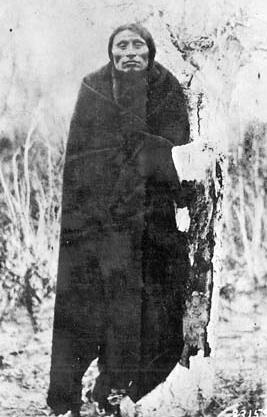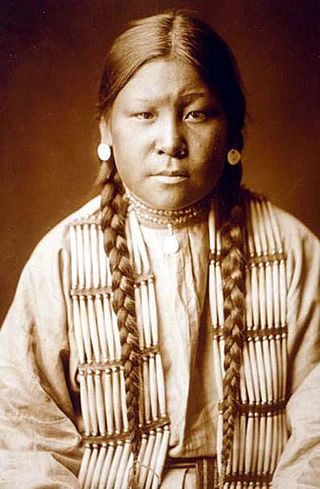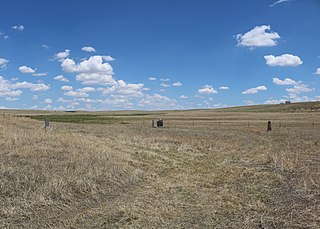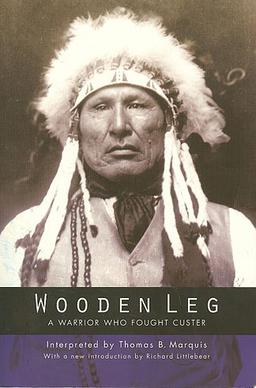Related Research Articles

The Crow, whose autonym is Apsáalooke, also spelled Absaroka, are Native Americans living primarily in southern Montana. Today, the Crow people have a federally recognized tribe, the Crow Tribe of Montana, with an Indian reservation, the Crow Indian Reservation, located in the south-central part of the state.

The Arapaho are a Native American people historically living on the plains of Colorado and Wyoming. They were close allies of the Cheyenne tribe and loosely aligned with the Lakota and Dakota.

The Cheyenne are an Indigenous people of the Great Plains. The Cheyenne comprise two Native American tribes, the Só'taeo'o or Só'taétaneo'o and the Tsétsėhéstȧhese ; the tribes merged in the early 19th century. Today, the Cheyenne people are split into two federally recognized nations: the Southern Cheyenne, who are enrolled in the Cheyenne and Arapaho Tribes in Oklahoma, and the Northern Cheyenne, who are enrolled in the Northern Cheyenne Tribe of the Northern Cheyenne Indian Reservation in Montana. The Cheyenne language belongs to the Algonquian language family.

Little Wolf was a Northern Só'taeo'o Chief and Sweet Medicine Chief of the Northern Cheyenne. He was known as a great military tactician and led a dramatic escape from confinement in Oklahoma back to the Northern Cheyenne homeland in 1878, known as the Northern Cheyenne Exodus.
The Dull Knife Fight, or the Battle on the Red Fork, part of the Great Sioux War of 1876, was fought on November 25, 1876, in present-day Johnson County, Wyoming between soldiers and scouts of the United States Army and warriors of the Northern Cheyenne. The battle essentially ended the Northern Cheyennes' ability to continue the fight for their freedom on the Great Plains.

William Wells Bent was a frontier trader and rancher in the American West, with forts in Colorado. He also acted as a mediator among the Cheyenne Nation, other Native American tribes and the expanding United States. With his brothers, Bent established a trade business along the Santa Fe Trail. In the early 1830s Bent built an adobe fort, called Bent's Fort, along the Arkansas River in present-day Colorado. Furs, horses and other goods were traded for food and other household goods by travelers along the Santa Fe trail, fur-trappers, and local Mexican and Native American people. Bent negotiated a peace among the many Plains tribes north and south of the Arkansas River, as well as between the Native American and the United States government.

Quillwork is a form of textile embellishment traditionally practiced by Indigenous peoples of North America that employs the quills of porcupines as an aesthetic element. Quills from bird feathers were also occasionally used in quillwork.

George Bird Grinnell was an American anthropologist, historian, naturalist, and writer. Originally specializing in zoology, he became a prominent early conservationist and student of Native American life. Grinnell has been recognized for his influence on public opinion and work on legislation to preserve the American bison. Mount Grinnell in Glacier National Park in Montana is named after him.

Buffalo Calf Road Woman, or Brave Woman, was a Northern Cheyenne woman who saved her wounded warrior brother, Chief Comes in Sight, in the Battle of the Rosebud in June 1876. Her rescue helped rally the Cheyenne warriors to win the battle. She fought next to her husband in the Battle of the Little Bighorn nine days later. In 2005, Northern Cheyenne storytellers broke more than 100 years of silence about the battle, and they credited Buffalo Calf Road Woman with striking the blow that knocked Lieutenant Colonel George Armstrong Custer off his horse before he died.
Wooden Leg was a Northern Cheyenne warrior who fought against Custer at the Battle of the Little Big Horn.

The Battle of Summit Springs, on July 11, 1869, was an armed conflict between elements of the United States Army under the command of Colonel Eugene A. Carr and a group of Cheyenne Dog Soldiers led by Tall Bull, who was killed during the engagement. The US forces were assigned to retaliate for a series of raids in north-central Kansas by Chief Tall Bull's Dog Soldiers band of the Cheyenne. The battle happened south of Sterling, Colorado in Washington County near the Logan/Washington county line.
Little Rock was a council chief of the Wutapiu band of Southern Cheyennes. He was the only council chief who remained with Black Kettle following the Sand Creek massacre of 1864.

Cheyenne military societies are one of the two central institutions of traditional Cheyenne native American tribal governance, the other being the Council of Forty-four. While council chiefs are responsible for overall governance of individual bands and the tribe as a whole, the headmen of military societies are in charge of maintaining discipline within the tribe, overseeing tribal hunts and ceremonies, and providing military leadership. Historically, council chiefs selected which of the six military societies would assume these duties; after a period of time on-duty, the chiefs would select a different society to take up the duties.

Wooden Leg: A Warrior Who Fought Custer is a 1931 book by Thomas Bailey Marquis about the life of a Northern Cheyenne Indian, Wooden Leg, who fought in several historic battles between United States forces and the Plains Indians, including the Battle of the Little Bighorn, where he faced the troops of George Armstrong Custer. The book is of great value to historians, not only for its eyewitness accounts of battles, but also for its detailed description of the way of life of 19th-century Plains Indians.

The Great Sioux War of 1876, also known as the Black Hills War, was a series of battles and negotiations that occurred in 1876 and 1877 in an alliance of Lakota Sioux and Northern Cheyenne against the United States. The cause of the war was the desire of the US government to obtain ownership of the Black Hills. Gold had been discovered in the Black Hills, settlers began to encroach onto Native American lands, and the Sioux and the Cheyenne refused to cede ownership. Traditionally, American military and historians place the Lakota at the center of the story, especially because of their numbers, but some Native Americans believe the Cheyenne were the primary target of the American campaign.

The Northern Cheyenne Exodus, also known as Dull Knife's Raid, the Cheyenne War, or the Cheyenne Campaign, was the attempt of the Northern Cheyenne to return to the north, after being placed on the Southern Cheyenne reservation in the Indian Territory, and the United States Army operations to stop them. The period lasted from 1878 to 1879.

George Bent, also named Ho—my-ike in Cheyenne, was a Cheyenne-Anglo who became a Confederate soldier during the American Civil War and waged war against Americans as a Cheyenne warrior afterward. He was the mixed-race son of Owl Woman, daughter of White Thunder, a Cheyenne chief and keeper of the Medicine Arrows, and the American William Bent, founder of the trading post named Bent's Fort and a trading partnership with his brothers and Ceran St. Vrain. Bent was born near present-day La Junta, Colorado, and was reared among both his mother's people, his father and other European Americans at the fort, and other whites from the age of 10 while attending boarding school in St. Louis, Missouri. He identified as Cheyenne.
This is a timeline of women in warfare in the United States up until the end of World War II. It encompasses the colonial era and indigenous peoples, as well as the entire geographical modern United States, even though some of the areas mentioned were not incorporated into the United States during the time periods that they were mentioned.
The Pawnee capture of the Cheyenne Sacred Arrows occurred around 1830 in central Nebraska, when the Cheyenne attacked a group from the Skidi Pawnee tribe, who were hunting bison. The Cheyenne had with them their sacred bundle of four arrows, called the Mahuts. During the battle, this sacred, ceremonial object was taken by the Pawnee. The Cheyenne initially made replica arrows but also tried to get the originals back. They recovered one from the Pawnee directly, either given to them or taken by them, and a second was captured by the Lakota and returned to the Cheyenne in exchange for horses. The two corresponding replicas were ceremonially returned to the Black Hills, where the arrows were traditionally believed to have originated. Eventually the bundles were re-established and the societies and their ceremonies continue into the present day.
Black Bear was an Arapaho leader into the 1860s when the Northern Arapaho, like other Native American tribes, were prevented from ranging through their traditional hunting grounds due to settlement by European-Americans who came west during the Pike's Peak Gold Rush. Conflicts erupted over land and trails used by settlers and miners. A watershed event was the Sand Creek massacre of 1864. This led to the Northern Arapaho joining with other tribes to prevent settlement in their traditional lands. In 1865, Black Bear's village was attacked during the Battle of the Tongue River. People died, lodges were set on fire, and food was ruined, all of which made it difficult for them to survive as a unit. He died during an ambush by white settlers on April 8, 1870, in the Wild Wind Valley of present-day Wyoming.
References
- ↑ Grinnell, George Bird; Fitzgerald, Joseph A. (2008). The Cheyenne Indians: Their History and Lifeways : Edited and Illustrated. World Wisdom, Inc. ISBN 978-1-933316-60-4.
- ↑ Chicago, Judy (2014-07-08). The Dinner Party: Restoring Women to History. The Monacelli Press, LLC. ISBN 978-1-58093-397-1.
- ↑ Southwestern Studies. Texas Western College Press. 1998. ISBN 978-0-87404-157-6.
- 1 2 Grinnell, George Bird (1962). The Cheyenne Indians Their History and Ways of Life.
- ↑ Snodgrass, Mary Ellen (2023-12-20). Women Warriors in History: 1,622 Biographies Worldwide from the Bronze Age to the Present. McFarland. ISBN 978-1-4766-5032-6.
- ↑ Tucker, Phillip Thomas (2002). Cathy Williams: From Slave to Female Buffalo Soldier. Stackpole Books. ISBN 978-0-8117-0340-6.
- ↑ "The Dinner Party: Heritage Floor: Ehyophsta". Brooklyn Museum: Elizabeth A. Sackler Center for Feminist Art. Retrieved 2013-08-13.
- Salmonson, Jessica Amanda (1991). The Encyclopedia of Amazons. Paragon House. Page 78. ISBN 1-55778-420-5
- Reader's Digest Association (1995). Through Indian eyes: the untold story of Native American peoples . Pleasantville, N.Y: Reader's Digest Association. ISBN 089577819X.